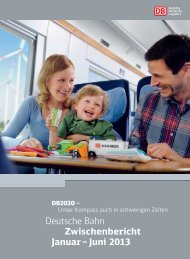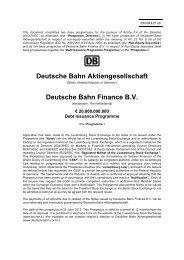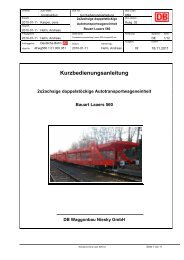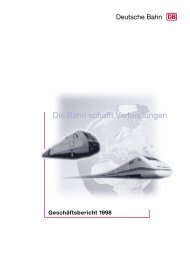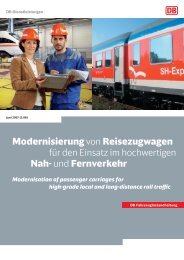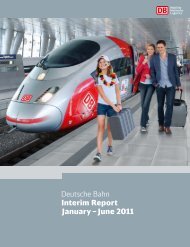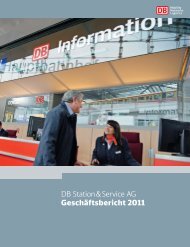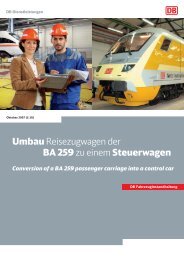PDF Download - Deutsche Bahn AG
PDF Download - Deutsche Bahn AG
PDF Download - Deutsche Bahn AG
You also want an ePaper? Increase the reach of your titles
YUMPU automatically turns print PDFs into web optimized ePapers that Google loves.
|<br />
mAN<strong>AG</strong>EmENT rEPOrT<br />
risk report<br />
a Integrated risk management ensures transparency<br />
a Material risks in areas of market, production, technology and procurement market<br />
a Risk portfolio free of existence-threatening risks<br />
Our business activities involve opportunities as well as risks.<br />
Our business policy is simultaneously directed at seizing oppor-<br />
tunities and actively controlling identified risks through our risk<br />
management system. The necessary information for this is<br />
prepared in our integrated risk management system, which<br />
conforms to the legal requirements of the German Control and<br />
Transparency Act in the Corporate Sector (Gesetz zur Kontrolle<br />
und Transparenz im Unternehmensbereich; KonTraG). This system<br />
is continuously further developed.<br />
riSK ManageMent witHin DB groUp<br />
The principles of risk policy are set by Group management and<br />
are implemented within DB Group. Within the framework of our<br />
early risk detection system, quarterly reports are submitted to<br />
DB <strong>AG</strong>’s management Board and Supervisory Board. risks or<br />
negative developments occurring outside of the regular reporting<br />
cycle must be reported immediately. Planned acquisitions are<br />
subject to additional special monitoring. Arriva, which was<br />
acquired during the year under review, has not yet been integrated<br />
into the DB Group’s risk management system. This integration<br />
process will take place during the first half of 2011.<br />
Within our risk management system all risks are shown in<br />
a risk portfolio as well as in a detailed listing, taking materiality<br />
thresholds into account. The risks mentioned in the risk report<br />
are categorized and classified based on the probability of occurrence.<br />
In addition to the possible consequences, the analysis<br />
also contains approaches to and the costs of countermeasures.<br />
In terms of organization, Group controlling serves as the<br />
coordination center for our risk management system within DB<br />
Group. In the context of Group financing, which is strictly oriented<br />
to our operating business, Group Treasury bears responsibility<br />
for the limitation and monitoring of the resultant credit, market<br />
price and liquidity risks. By consolidating the related transactions<br />
(money market, securities, foreign exchange or derivative<br />
transactions) at DB <strong>AG</strong> level, the associated risks are centrally<br />
controlled and limited. Group Treasury is organized to comply<br />
with the “minimum requirements for risk management”<br />
(marisk) formulated for financial institutions and, applying the<br />
criteria derived from these guidelines, fulfills all requirements<br />
of the KonTraG.<br />
Key characteristics of the internal control<br />
and risk management system with regard to the<br />
Group’s accounting<br />
Our risk management system is supplemented by a Group-wide<br />
internal control system, which also includes accounting-related<br />
processes.<br />
Our internal control system is aligned with criteria defined<br />
by the Committee of Sponsoring Organizations of the Treadway<br />
Commission (COSO) publication: “Internal Control – Integrated<br />
Framework”. The COSO model is a generally accepted theoretical<br />
framework that divides an internal control system into five levels<br />
and then evaluates each level individually. Based on this model,<br />
our accounting-based internal control system is supported by<br />
fundamental control mechanisms such as system-technical and<br />
manual coordination, separate and clearly defined functions,<br />
and the observance of guidelines that are applicable across the<br />
Group, and special work instructions.<br />
In addition to the aforementioned instruments the following<br />
accounting-based control mechanisms are used in DB Group:<br />
unified Group-wide reports based on the standard software<br />
Hyperion Financial management (HFm) are prepared by all of<br />
the consolidated companies that are documented in our core<br />
corporate information system (Firmen Informations System;<br />
FIS), the systematic tracking of changes in accounting rules<br />
based on IFrS or the German Commercial Code (HGB), the<br />
regular and comprehensive update of the corresponding balance<br />
sheet guidelines and accounting-based systems, the uniform<br />
item number plan and the provision of the necessary information<br />
to the persons responsible for preparing the reports. The audit<br />
activities of the corporate auditors, which represent a key<br />
element of our control activities as a process independent<br />
instrument, are focused on evaluating the appropriateness and<br />
effectiveness of our internal control system. Beyond this, audits<br />
are also conducted within the framework of inventories of assets<br />
and reserves. Our control mechanisms are complemented by<br />
the work of the audit and compliance committee, respectively<br />
the Supervisory Board, as well as by the activities of the Group<br />
auditor during the execution of his legally mandated audit.<br />
Based on a binding schedule for closing the books,<br />
accounting materials are prepared by the decentralized bookkeeping<br />
departments in accordance with IFrS principles and<br />
29



